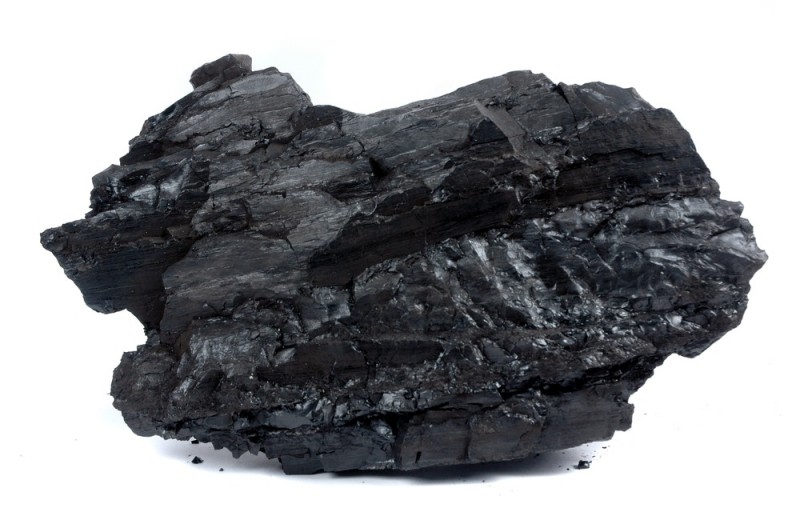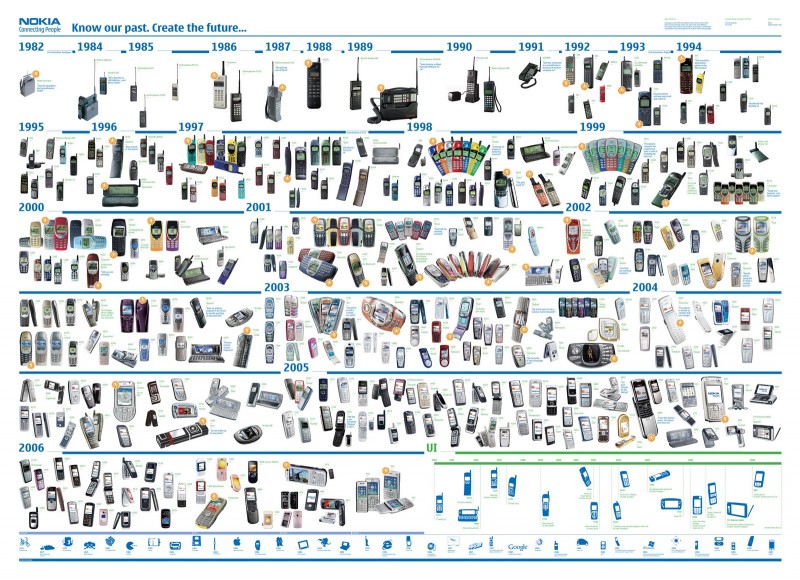Dark Psychedelia
Keywords: anthropology, brain simulation, Discussion, earth simulation, experience, fossils, Gean Moreno, Michael Jones McKean, perception, philosophy, principles of light, rainbow, science, time
Gean Moreno in conversation with Michael Jones McKean
Dark Psychedelia
A conversation between Gean Moreno and Michael Jones McKean
Gean Moreno: Let’s begin by talking about how time functions in your projects and just see where this takes us.
Michael Jones McKean: One way time is often addressed is through handling objects as if they were already artifacts. When viewed this way, contemporary objects shed some of their present day qualities, and in doing so, become encoded with a stranger, but perhaps clearer relationship to time. So, as an archaeologist might understand profound and hidden away details about a Neolithic hand axe through analyzing its shape and materiality, someone in a thrift store picking up a by-now ancient Motorola Razr might feel the precise psychic pangs of a pre-crisis 2006. In both cases, each object claims an idiosyncratic, but precise time signature.
Very much related to time, we’re witnessing our lived-through Middle Anthropocenic Period rapidly consolidate into a super sophisticated monoculture, where massive objects like Samsung, The Black Forest, Liberia, the Renminbi, and a copper mine in Chile operate interdependently within ultra-networked systems. To this, we’ve learned that when we burn coal and oil we’re blazing through 300 million years of compounded growth and decay – stored and compressed time – at an unimaginably accelerated rate. This sudden and hyperbolic release of energy creates a radical reconfiguration to our conception of time, while in the process disrupting seemingly stable systems: climates, migrations, economies, ecologies, our evolving human psychology, space itself. Heidegger’s musings about airplane travel fucking with distance/nearness/time seem quaint now, with algorithmically-enhanced high frequency trade distorting capital even further, or machines like the Large Hadron Collider spinning particles at obscene speeds, effectively time-traveling to the nanosecond following the universe’s creation. Or even the very real science of de-extinction as it plays out over the next few years. In all cases, the reliability of time’s arrow – even death itself – becomes more lost in an inchoate warp flow.
Bringing it back to the work, maybe the project that consolidates my interest in time most clearly is certain principles of light and shapes between forms (2012) – the central component being a real, prismatic rainbow. The rainbow form collapses time. It lives unbeholden to circadian, glacial, and geologic registrations, lacking any sort of time signature at all. The rainbow form unbinds itself from these kind of object-oriented archeo-clocks. Immune to age or even evolution, its essential character is consistent in Nairobi, Singapore or Manitoba; in 20,000 BC or 3,000 AD. What we see, when we see one, is the crystallization of an unyielding set of physical principles conspiring together – the tilt of the earth in relation to the sun, light waves racing through the upper and lower atmospheres, the proper density of water-prism-drops––all held in precise alignment. These integers form a code sequence that is oblivious, in some deep ontological sense, to the passage of time.

Michael Jones McKean, Certain principles of light and shapes between forms (2012), harvested and reclaimed rainwater, 110 pound 5000 year old Campo del Cielo meteorite, conch shell from Micronesia, handmade American quilt circa 1880, antique glass prism, Bristlecone Pine, white light emitter, photo background stands, muslin, six 10,500 gallon water storage tanks, modified downspout system, 60 horse power turbine pump, UV water filter, galvanized piping

Michael Jones McKean, Certain principles of light and shapes between forms (2012), harvested and reclaimed rainwater, 110 pound 5000 year old Campo del Cielo meteorite, conch shell from Micronesia, handmade American quilt circa 1880, antique glass prism, Bristlecone Pine, white light emitter, photo background stands, muslin, six 10,500 gallon water storage tanks, modified downspout system, 60 horse power turbine pump, UV water filter, galvanized piping
The reverse is that observing a rainbow-event is an incredibly durational experience – another kind of time altogether. I imagine its attraction and importance to so many cultures throughout history is partly due to its fleeting nature. The pronounced gap between these two time registers – both here-and-now, and out-of-time – summarize a lot of my interests with objects and sculpture.
GM: But these two time registers — exo-temporal and now-durational — are complicated in this case. The exo one, which as you say in some way unbinds the rainbow from any specific time and makes it immune to age and evolution, is interesting in that it indexes a kind of absolute time––something beyond our temporalities, if you like. One can imagine the rainbow existing before the possibility of chronological time as we experience it was conceptualized. In fact, one can imagine it before the very possibility of conceptualization, of thought. Unburdened by any need for carbon-based life forms in its production, one can posit the rainbow as a figure, even if devoid of all the meaning we’ve pinned to it, that points to a moment prior to the emergence of life and of a chronological understanding of time.
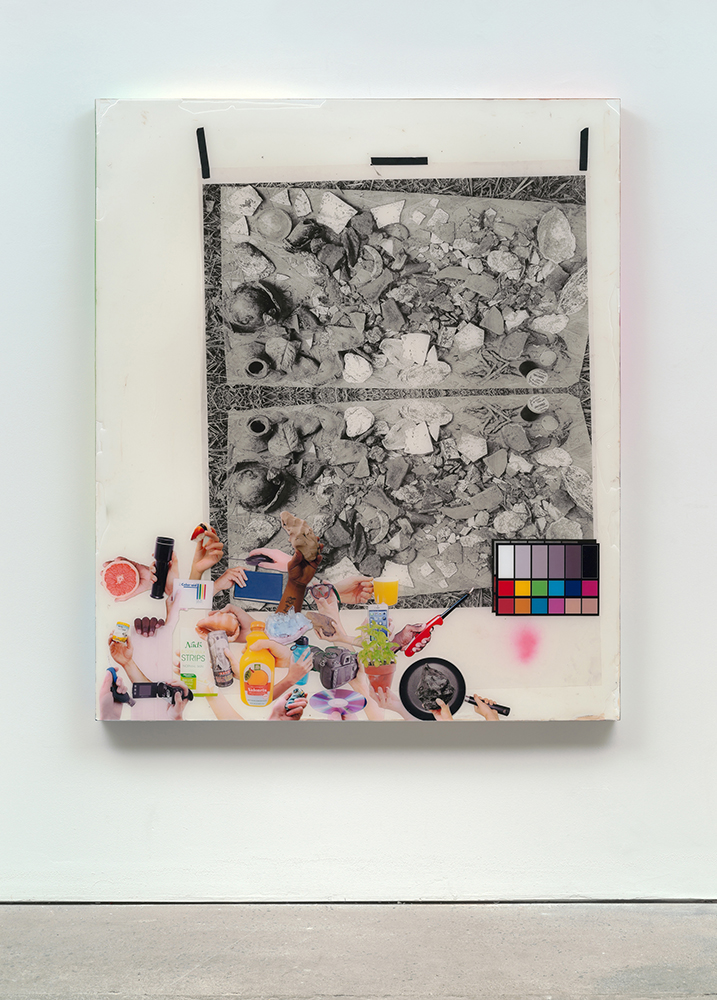

MJM: Yes, in a speculative, almost psychedelic way one can also imagine how aesthetics and maybe even our conception of the sublime might have co-evolved with naturally occurring out-of-time forms. Rogue synaptic pathways traveling in the brain could have become organized and grooved by witnessing phenomena like the sun rising or an ocean wave crashing, or for that matter, a rainbow. Near the origins of cognitive intelligence, what were the forms that proto-humans had available, and how did these forms imprint themselves on our psyches? Just as our neural capacity for abstraction might have been born and honed while gazing at shifting cloud formations or mentally drawing shapes in the night sky, the rainbow form might have helped prototype our modern understanding of the sublime.
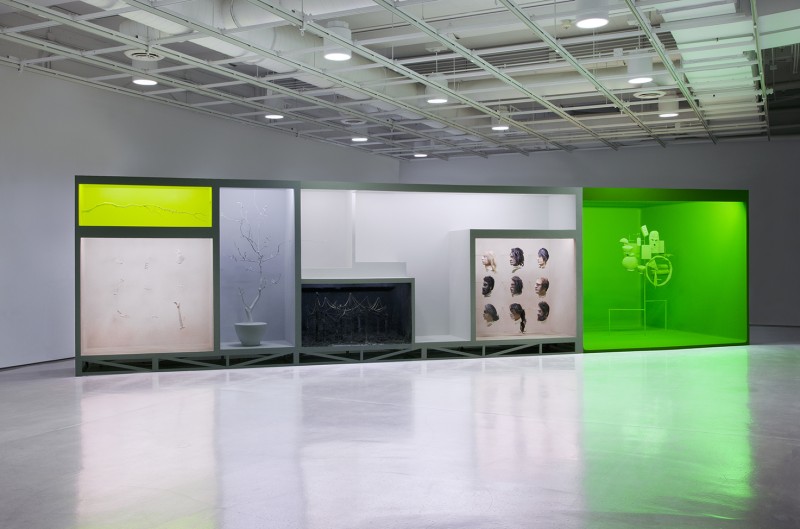
Michael Jones McKean, The Religion (2013), plywood, pine, paint, epoxy resin, stainless steel, fluorescent lights, dirt, cement, clay, wigs, prosthetic silicon, makeup, clothing, jewelry, chains, 36 x 8.5 x 8 feet
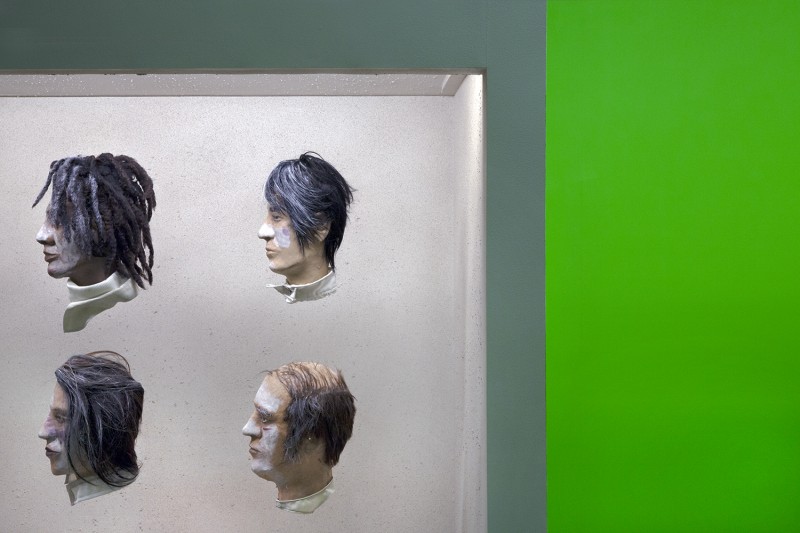
Michael Jones McKean, The Religion (2013), plywood, pine, paint, epoxy resin, stainless steel, fluorescent lights, dirt, cement, clay, wigs, prosthetic silicon, makeup, clothing, jewelry, chains, 36 x 8.5 x 8 feet
GM: But it may be more wicked that this. The form may index a moment before synaptic pathways, before life and witnesses. A world that precedes us. A world like the one I imagine after biological extinction. Maybe the rainbow, as part of a world that was there before life and that will be there after it, is a paradoxical and unexpected element of a black psychedelia, of the morosely tripped out possibility of us actually not being around. It casts long shadows over, and opens deep voids in, thoughts that orbit an inorganic world.
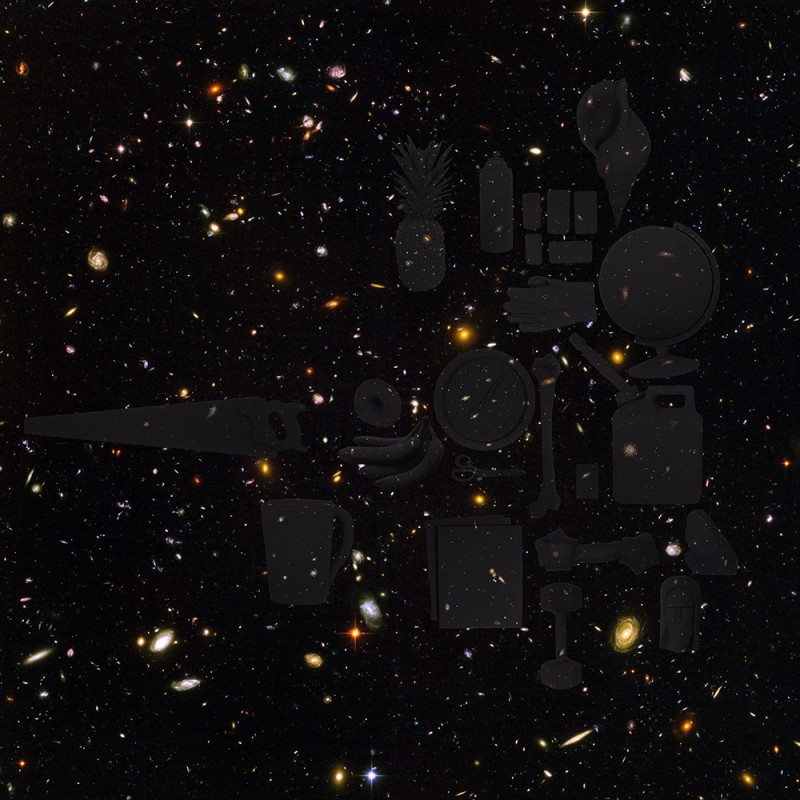
Michael Jones McKean, The Deep Field (2014), Hubble Ultra Deep Field Image, ink on vinyl, telescopic banner stand, 80 x 80″

Michael Jones McKean, The Deep Field (2014), Hubble Ultra Deep Field Image, ink on vinyl, telescopic banner stand, 80 x 80″
MJM: The concept of black psychedelia opens up really strange territory. It also feels metaphorically apt – blackness as the compression of the visible spectrum, or color’s acid black inversion. And yes it’s wild to imagine the rainbow reporting to us from the edge-time, a history before our existence, as it races out prophesying a post-human future without us.
However it’s important to mention that through all recorded history – real and mythological – the rainbow exists for humans as a profoundly associative event. It appears as a message from a divine force conjuring proof of creation, or an omen of luck, doom, goodwill, democracy, LGBT pride, hope… The overwhelming spell that the popular rainbow form collectively has cast on us has reached an obsessive perversion. For the object to regain consciousness in sculptural form, it was necessary to escape the orbit of kitsch and branding, symbology and cartooning – all things that bind it pathologically to our cultural moment. It seemed necessary to reverse polarities regarding its image and embrace its origins as an object. An object not in contempt of us, but dissociated from us – living in another orbit of private omniscience.
As a thought experiment, Meillassoux’s idea of ‘objects without us’ or his concept of the ‘arche fossil’ – which your question maybe alludes to – feels immensely generative. In practice, though, we’re still taking the first steps at actualizing the promises of de-anthropomorphism, toward realizing a production that utilizes its offerings. This brings to mind a term you used a couple of weeks back over lunch: the ‘beta version of ourselves.’ It has me wondering if multiple forces conspiring toward some ad hoc singularity might be pointing the way – the kind of reverse myopia that, say, the release of the Hubble Ultra-Deep Field photograph induces, or the very real way in which social media slowly extends our minds into the hive, or any number of advances in understanding the intelligence of plantlife, new theories about emotion, how exactly our epigenome works…
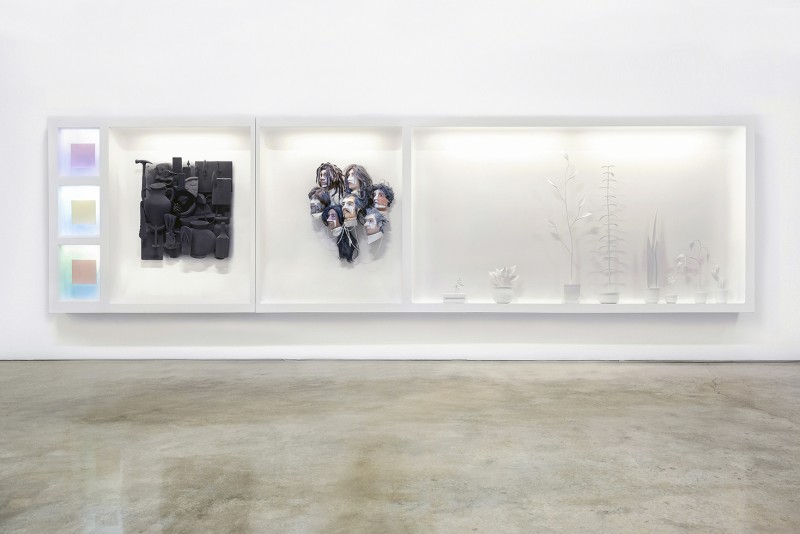
Michael Jones McKean, The Garden (2014), wood, shellac, wax, prosthetic silicone, makeup, jewelry, hair, fabric, lights, stainless steel, resin, rubber, tar, plastic, embedded meteorite fragments including: Canyon Diablo Meteorite – Northern Arizona, estimated fall 50,000 years ago; Campo del Cielo Meteorite – Argentina, estimated fall 4000 BC; Gibeon Meteorite – Namibia, no recorded fall, discovered 1836; Oued el Hadjar Meteorite – Morocco, recorded fall 1986; Sikhote-Alin Meteorite Eastern Siberia – recorded fall 1947; Katol, Meteorite – India, recorded fall 2012; Bondoc Meteorite – Philippines, no recorded fall, year found 1956; Nantan Meteorite – China, recorded fall 1516, year authenticated 1958. 64 x 229 x 9″

Michael Jones McKean, The Garden (2014), wood, shellac, wax, prosthetic silicone, makeup, jewelry, hair, fabric, lights, stainless steel, resin, rubber, tar, plastic, embedded meteorite fragments including: Canyon Diablo Meteorite – Northern Arizona, estimated fall 50,000 years ago; Campo del Cielo Meteorite – Argentina, estimated fall 4000 BC; Gibeon Meteorite – Namibia, no recorded fall, discovered 1836; Oued el Hadjar Meteorite – Morocco, recorded fall 1986; Sikhote-Alin Meteorite Eastern Siberia – recorded fall 1947; Katol, Meteorite – India, recorded fall 2012; Bondoc Meteorite – Philippines, no recorded fall, year found 1956; Nantan Meteorite – China, recorded fall 1516, year authenticated 1958. 64 x 229 x 9″
GM: I know what you mean regarding the difficulty of translating certain speculative lines of thinking into actual physical production, but I also feel that it’s very fertile territory. While sculptural objects will always end up in some kind of transaction with human bodies and their desire for meaning, this may be a historical contingency. Maybe other ways of engagement are possible. What if meaning is deposed as the sole goal of cultural artifacts? What if instead of significance, they diagram unfathomable processes, they point to things that exceed our capacity to fully comprehend them? What if they could just throw us out over a void, zap us with dark affect, and not crystallize into a tight ball of meaning?
MJM: I agree, this kind of old-timey semantic engagement with objects and images looks a little quaint as an end game. Moreover, the collateral damage of developing thought this way seems violent – like 100 million realities, a Babel of kaleidoscopic dimension, razed in pursuit of something hermeneutic.
Still, the question becomes difficult when we consider our neurobiological baseline. We can’t overcome our prefrontal cortex, the brain-space where we process connections, solve problems, build abstractions and think toward an understanding of thought. As an organ, it’s the awesome distillation of slow, beneficially adaptive evolutions enabling us to survive, in part, through creative problem-solving. In this way, humans might be conscripted to meaning-making as an evolutionary default, leading us back to the beta human idea – Homo Sapiens as new Homo Erectus. The question becomes: is there a way to actively rewire our brains, or at least fool them into functioning more unexpectedly?
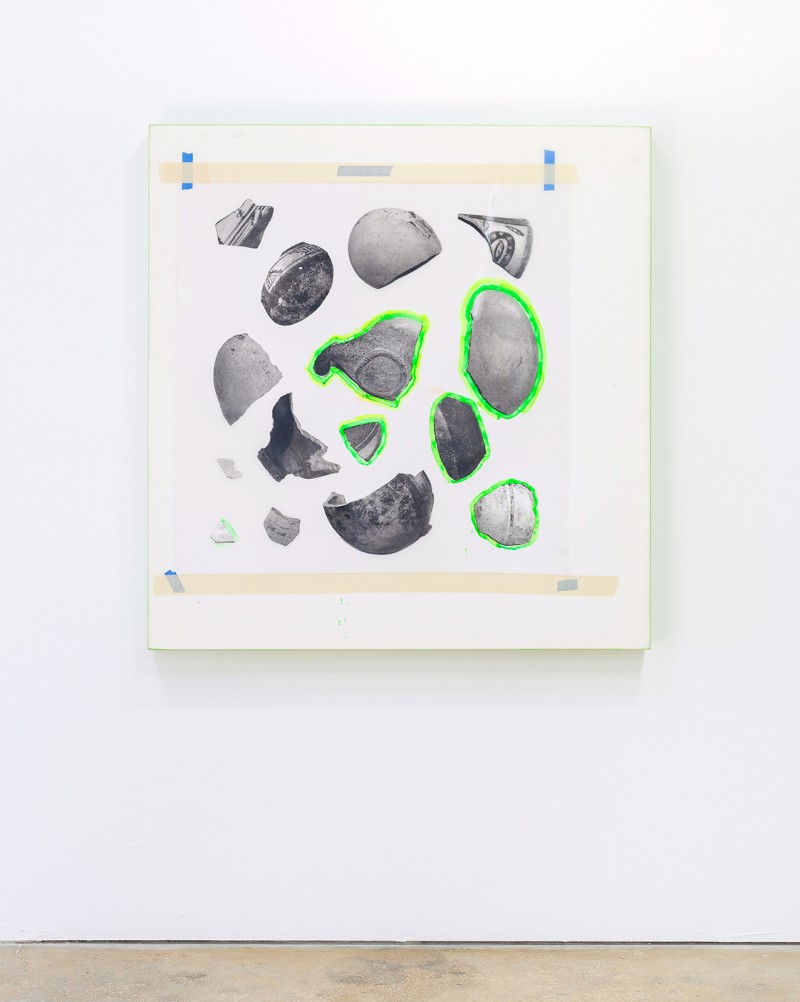
Michael Jones McKean, Gliese 667C c, Kepler-22b, Kepler-69 c, Kepler-62e, Tau Ceti e, Gliese 180 c, Gliese 667C f, Gliese 180 b, HD 40307 g, Kepler-61 b, Kepler-62 f, Kepler-186 f, Gliese 180 b, Gliese 682 b, Kepler-296 f (2014) (wood, black and white print, tape, resin, SeaMarker rescue dye, paint, insects)
GM: Some of this rewiring may be afoot. Neuroscience doesn’t tire of challenging our cherished idea of a phenomenal self. Certain strands of it are proposing the the notion of a self is just an evolutionary prop. There literally is no such thing as a self, just chemicals firing up the illusion of such a thing as a survival mechanism. It constantly reminds us that there is no “me” beyond the biochemistry. Once this knowledge seeps into the general culture and replaces our “common-sense” understanding of who and how we are, who knows what biological and cognitive consequences will follow?
But let’s turn to the now-durational time register of the rainbow component of certain principle of light and shapes between forms, which is complicated, I think, in a different way than the “exo-temporal register.” The rainbow is, in some sense, “faked”–that is, mechanically produced–which leads me to its relation to the thoroughly artificially-generated time of spectacle. I’m not thinking of spectacle in a Debordian sense, as much as in relation to the construction of mechanical artifacts. Artifacts that generated events or temporal experiences that shadowed the Industrial Revolution and have crossed over, perhaps amped up, into our digital age. The generation of these events, akin to the production of certain adrenaline-inducing activities like roller coasters and gambling, seem to me –here the spectacle has more to do with Benjamin’s reading of modernity than with Debord’s–to participate in the shock therapies that helped us through the shocks of modernity. The shock of the assembly line was tempered by the controlled shock of the roller coaster. I think the “faked” durational aspect of the rainbow in some way participates in this. Or, at the very least, channels the methods and desire for particular results that come down through modernity into the experience architectures that rise up around us. Out of tune with the mythical or poetic dimensions of the rainbow, as a mysterious event-thing found in nature or whatever, we now have to invent a mirage of it. And the time of this mirage has to be, surely, at an ontological level, different from the “non-fake” time we inhabit.
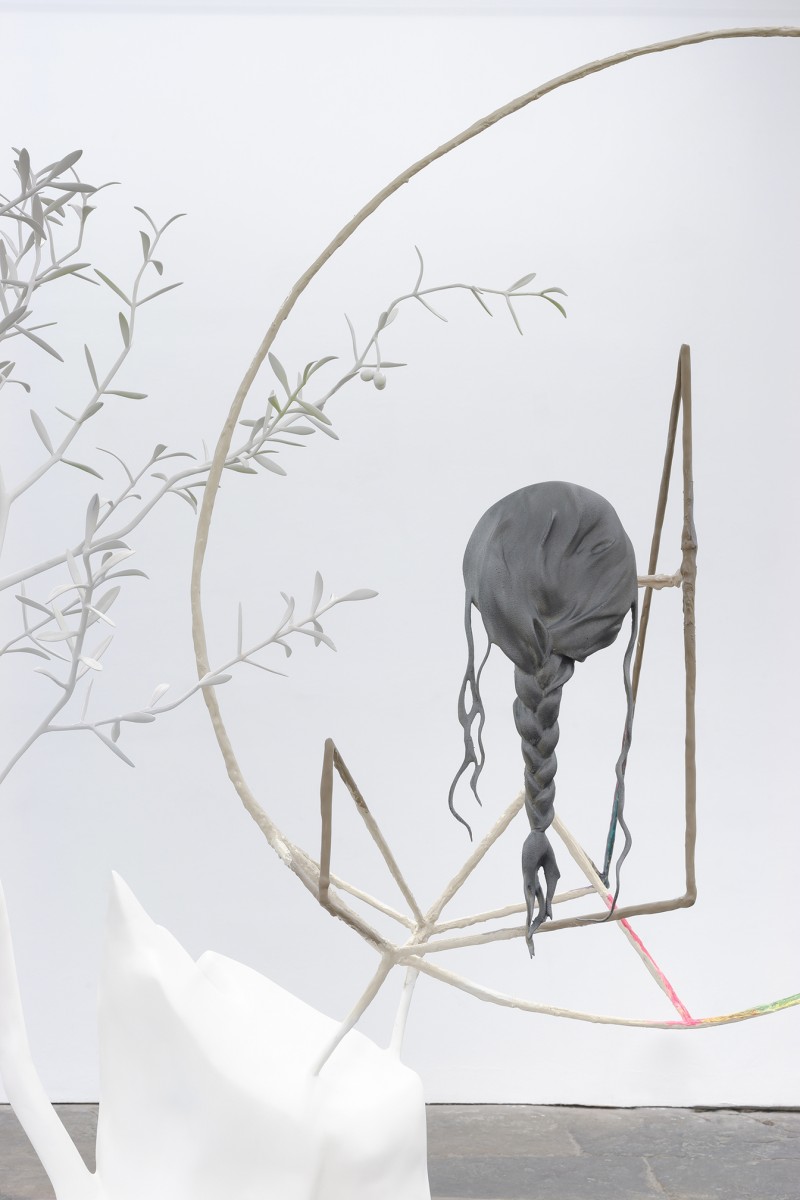
Michael Jones McKean, Sister Giving Birth, detail (2013), resin, wood, embedded hair, stainless steel, paint, 84 x 84 x 39″
MJM: You hit on some important concepts. As you mention, the project is odd in that it’s simultaneously an actual rainbow, composed of the same substances, optics, and geometry of the real artifact – in some ways not unlike a readymade – and also a construction, a representation, a fiction. ‘Mere’ when measured against the mythical version you mention. In this way, the project seems all wonky and deranged, a little drunk. I don’t see this as an error or miscalculation, but a reflection of the process of representation itself. Through the machinations of producing a one-off this way – some kind of post-representation representation – it offers-up a self-signifying reality whose relation to time ends up being super elastic.
GM: The distinction between readymade and one-off recalls another time involved in the project: let’s call it the time of planning and production. It took a very long time to get this off the ground. And what is interesting, too, is that all kinds of experts in other fields–engineers, irrigation professionals, etc.–had to be incorporated. This time, I imagine, is registered less in the actual experience generated than in all the infrastructure assembled and installed.
MJM: Time in relation to production and labor isn’t a combination I usually think much about. Of course there are models for artwork where labor becomes a proxy for value or the meaning itself. Like how negotiating, talking, networking, and collaborating become investments in something relational, where one’s time is aestheticized. I’m not interested in performing work. The exchange risks becoming an artifact or an end, rather than a real and powerful means to something more.
With this project and some others, I’ve been working on problems with a high enough degree of difficulty that collaborations are born naturally, out of necessity and from the strong valent attraction they emit. In the end, the relationships that are forged are totally unperformed – unmediated by the desire to collaborate at all.
GM: I was thinking of this time not as somehow aestheticizing the collaboration with all these experts. I was thinking of it more as evidence of something like “infrastructural thinking.” I’m not quite sure what the term means, but it has something to do with complicating the idea and the “necessity” of the discrete object. It seems that increasingly interesting sculptural objects need to be plugged into different lines of production and thinking. It has something to do with networks, but also with tying the vague or ethereal idea of the network into actual physical practices and fields.
MJM: I think I understand you better. An artwork can be imagined as an emergent and metabolic structure, an organism that, if it’s to thrive, must keep absorbing and feeding. This project both necessitates and invites infra-level thinking, so the artwork is serviced by science, engineering, architecture, social relationships, and local governance, and on a intra personal level with the mayor, city planners, scientists, arborists, riggers, irrigation specialists, app coders, curators, writers. As a project absorbs more and more, it creates its own gravitational field. All these interactions form an essential mezzanine level of the project, allowing things to weave in and out of civic scales, from communities, down to households, and our own interior lives and dreams. The resulting meshwork plugs into a style of problem-solving that is perhaps infra-structural in its process.
GM: I like that you used the analogy of a mezzanine for the infra space or activity of the project. It places us in a more architectural field, in some “outside” in relation to the discrete sculptural object. And maybe we can use this as a way to talk about new possibilities of sculptural dimensionality. A few years ago James Meyer wrote about the rise of size in sculpture at the expense of scale. Size was what was needed to spectacularly fill the new mega museums. Scale, charged positively in this account, is what sculptures used to actively engage with by creating a relationship with human bodies and what used to be proportionally sized architectural/exhibition spaces. Meyer proposes Olafur Elliasson’s The Weather Project as a paradigmatic culprit in the perpetuation of Size. I find this binary between good scale and bad (spectacular) size a little dusty. I think there has to be a different conception of Size. It may be true that gigantic new museums have hypertrophied certain sculptural qualities by forcing them to swell unreasonably, but it is also true–or rather, this is the question–that this networked and globalized world that has generated these mega museums has also opened some new space to drive sculpture through.
Size, I think, need not always be defined as scale detrimentally swollen to spectacle; it can name objects with swollen infra or mezzanine levels. Objects that emerge out of a scaffolding of networks and enlarged fields of relations and which, in order to maintain an internal logic with this mode of production, can no longer rely on a final morphology that is tuned to the scales of the human body.
MJM: Yes, but more, as infra or mezzo-level engineering might reveal new possibilities for size and scale, we could also add the concept of ‘scope.’ to the equation. While size and scale might best be measured in centimeters, proportion, volume, or girth, ‘scope’ seems to gauge range or saturation – an expanding and contracting field that encompasses objects and images. In the Age of Hyperobjects and the waning days of Web 2.0, where traditional ideas of size and scale seem inadequate, scope describes different forms of dimensionality. But you’re right, by dissing on size, we dispense with an essential tool enabling the possibility of real contributions to the issues of our time. As many artists retool to extend out of an attention economy paradigm, it will be the sensitive juggle-triangulation of all three – size, scale and scope – where the fruit might lie.
I wonder if some of the ‘size’ backlash you mention comes from a critical orthodoxy still charging art as a watchdog of global capitalism – that art should hold these systems in check by critiquing them through its machinations. And if actual participation is required, it should exist as a formal element, properly end-noted to hedge against complicity. It’s important to qualify this, as I’m not advocating blind acquiescence to these power structures, especially with so many limpen artworks willfully participating in the DeBordian size/spectacle dialectic you describe. Yet, as outlets to produce work with greased-up currency increase, its interesting to imagine ways – and the ‘infra’ is called to mind here – that artists might join the table through the back door and get to deploying size that raw capital might afford in stranger and less predictable ways. The process embraces an accelerated movement through capital as a means of eventually escaping it – some baseline Accelerationist thinking I suppose.
Thinking a little back to an earlier topic in relation to these systems, if a de-anthropic state were ever to actualize, the planet in some sense would shrink. We could no longer divide the world up, the human world and the natural world would merge into one world, and moral-ethical distinctions currently separating ‘natural’ and ‘synthetic’ production would melt away. By recognizing survival, adaptation, and propagation as emergent biological patterns contained with the embedded directives of cities, athletic teams, brands and corporations, they would become as natural as apple trees, bird flocks, sea coral, or invasive species for that matter.
The mental reprogramming needed to roll back anthropomorphism is already being seeded with Moore’s Law-like strides in science and technology. But these advances are entangled with all sorts of sideways questions and opportunities. For instance, as human and nonhuman worlds Venn together, could a hyper-empathic state emerge creating new forms of solidarity with objects, substances, mammals, plant life, gender, countries, weather, global warming? – like the promise of Object Oriented Ontology revealed itself as a techno infused pan-animism only with massive downstream socio-political perks. Or, as we evolve from the shadow of our beta-selves, how do we navigate the social/cultural pitfalls that emancipation though encryption, 24/7 surveillance and billions of data-mined objects with IP addresses would induce – or is acquiescence and acclimatization to this condition just a waypoint in our march toward unimagined freedoms and networked omniscience? As we and eclipse our understanding of human finitude with newly acquired exo-capacities can we learn to disappear in new, more meaningful ways long enough to diagram these new dimensionalities that the expansion into ultra-networked infra and mezzo ecologies might invite? With an entire generation of artists groomed in the glow of screens, how will the asymmetrically large amounts of content entering our brains lead to the adoption and implementation of new practices, new morphologies, more or less coherent fields of emotion? And in the present tense, how might our murmuring anxieties induced by massive uncertainty, anticipation, accelerating velocity and the omnipresent specter of disaster be re-channeled? The degree to which we might be both excited by these sorts of propositions, yet also intensely fearful of them describe exactly the generative and optimized working conditions artists seem actively in pursuit of.
Gean Moreno is an artist and writer based Miami. He is currently Artistic Director at Cannonball.
Michael Jones McKean is an artist based in New York City and Richmond, Virginia where he is an Associate Professor in the Sculpture + Extended Media Department at Virginia Commonwealth University.

